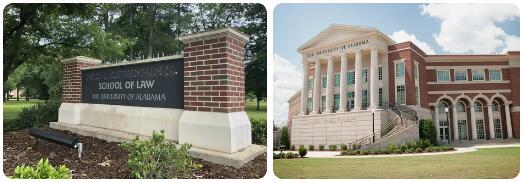The University of Alabama School of Law was established in 1872, making it one of the oldest law schools in the country. The School of Law was originally housed in Little Round House, an old wooden building located on the University’s campus. In 1923, the law school moved to its present location on Paul W Bryant Drive. The current building has been renovated several times since then to accommodate an ever-growing student body.
Since its establishment, the School of Law has continued to produce some of the country’s best legal professionals. Notable alumni include Hugo Black, who served as a Supreme Court Justice from 1937-1971 and Jeff Sessions, who served as United States Attorney General during 2017-2018. The school has also seen many prominent faculty members over the years including Robert J. Norrell and William H. Atwell II; both of whom have made significant contributions to legal scholarship and teaching at UA Law. Today, UA Law continues to be one of the top ranked law schools in the country with a highly selective admissions process and rigorous coursework that prepares students for successful careers in the legal profession.
University of Alabama School of Law is located in the state of Alabama. As one of the leading law programs, University of Alabama School of Law has a high average LSAT score of 160-166 when recruiting new students. As a return, the median starting salary for law graduates reaches $90,000 per year. See the following table for detailed admissions information and career profiles of University of Alabama School of Law.
Admissions: University of Alabama
The University of Alabama School of Law is a highly competitive law school, with an acceptance rate of just 24%. In the most recent admitted class, there were 699 applicants and only 167 were accepted. Those accepted had an average LSAT score of 164 and an average GPA of 3.76. The school also has a diverse student body, with students coming from all 50 states and over 30 countries. Additionally, the school offers scholarships to incoming students based on merit and need, making it possible for more people to attend this prestigious institution. The school also has over 20 student organizations that provide opportunities to get involved in the legal community outside of the classroom. With faculty from top law schools across the nation, as well as a variety of experiential learning opportunities, such as clinics and externships, the University of Alabama School of Law is an excellent choice for anyone looking to further their education in law.
| Fall 2019 Admissions and Enrollment Statistics | |
|---|---|
| Total number of full- and part-time applicants | 1,403 |
| Total number of full- and part-time acceptances | 459 |
| Overall acceptance rate | 32.7% |
| Total number of full- and part-time first-year students enrolled | 184 |
| Number of full-time program applicants | 1,403 |
| Number of full-time program acceptances | 433 |
| Full-time acceptance rate | 30.9% |
| Number of first-year full-time students enrolled | 164 |
| Number of part-time program applicants | N/A |
| Number of part-time program acceptances | 26 |
| Part-time acceptance rate | N/A |
| Number of first-year part-time students enrolled | 20 |
| Fall 2019 GPA and LSAT Scores | |
| 25th-75th percentile GPA scores for all students | 3.32-3.9 |
| 25th-75th percentile LSAT scores for all students | 159-165 |
| 25th-75th percentile undergraduate GPA for full-time students | 3.42-3.91 |
| 25th-75th percentile LSAT scores for full-time students | 160-166 |
| 25th-75th percentile undergraduate GPA for part-time students | 3.02-3.75 |
| 25th-75th percentile LSAT scores for part-time students | 153-165 |
Careers: University of Alabama
| Bar Statistics (Winter and Summer 2018 administrations) | |
|---|---|
| State where the greatest number of first-time test takers took the bar | AL |
| School’s bar passage rate for first-time test takers | 96.9% |
| Statewide bar passage rate for first-time test takers | 79.0% |
| Class of 2018 Graduates | |
| Total graduates | 157 |
| Graduates employed at graduation | N/A |
| Graduates known to be employed nine months after graduation | 96.9% |
| Starting Salaries of 2018 Graduates Employed Full-time | |
| 25th percentile private sector starting salary | $63,000 |
| Median private sector starting salary | $90,000 |
| 75th percentile private sector starting salary | $102,000 |
| Percent in the private sector who reported salary information | 70% |
| Median public service starting salary | $43,750 |
| Areas of Legal Practice (Class of 2018) | |
| Percent employed in academia | 1.0% |
| Percent employed in business and industry | 13.0% |
| Percent employed in government | 15.0% |
| Percent employed in all judicial clerkships | 12.0% |
| Percent employed in law firms | 54.0% |
| Percent employed in public interest | 4.0% |
| Percent employed in an unknown field | 1.0% |
| Percent employed in a judicial clerkship by an Article III federal judge | 7.0% |
| 2018 Graduates Employment Location | |
| Graduates employed in-state | 61% |
| Graduates employed in foreign countries | 2% |
| Number of states where graduates are employed | 18 |
| New England (CT, ME, MA, NH, RI, VT) | 0.0% |
| Middle Atlantic (NY, NJ, PA) | 2.2% |
| East North Central (IL, IN, MI, OH, WI) | 0.7% |
| West North Central (IA, KS, MN, MO, NE, ND, SD) | 0.7% |
| South Atlantic (DE, DC, FL, GA, MD, NC, SC, VA, WV) | 19.9% |
| East South Central (AL, KY, MS, TN) | 66.2% |
| West South Central (AR, LA, OK, TX) | 3.7% |
| Pacific (AK, CA, HI, OR, WA) | 2.2% |
| Mountain (AZ, CO, ID, MT, NV, NM, UT, WY) | 2.2% |
| Employment location unknown | 0.0% |
| Career Services | |
| (Data appear as originally submitted by this school) | |
| Career services operations | Strong alumni network. Concerned staff. Shadow Program. Practice Interviews. Alumni Mentor Program. Job fairs. Resume, interviewing, and cover letter workshops. Practice area panels. Internet-based career services management system. |
| Job Type | |
| Bar admission required or anticipated (e.g., attorney and corporate counsel positions, law clerks, judicial clerks) | 90.0% |
| J.D. preferred, law degree enhances position (e.g., corporate contracts administrator, alternative dispute resolution specialist, government regulatory analyst, FBI special agent) | 4.0% |
| Professional/other (jobs that require professional skills or training but for which a J.D. is neither preferred nor particularly applicable; e.g., accountant, teacher, business manager, nurse) | 4.0% |
| Nonprofessional/other (job that does not require any professional skills or training or is taken on a temporary basis and not viewed as part of a career path) | 1.0% |









